All Management News
- Blockchain Technology and its applications. September 22, 2022
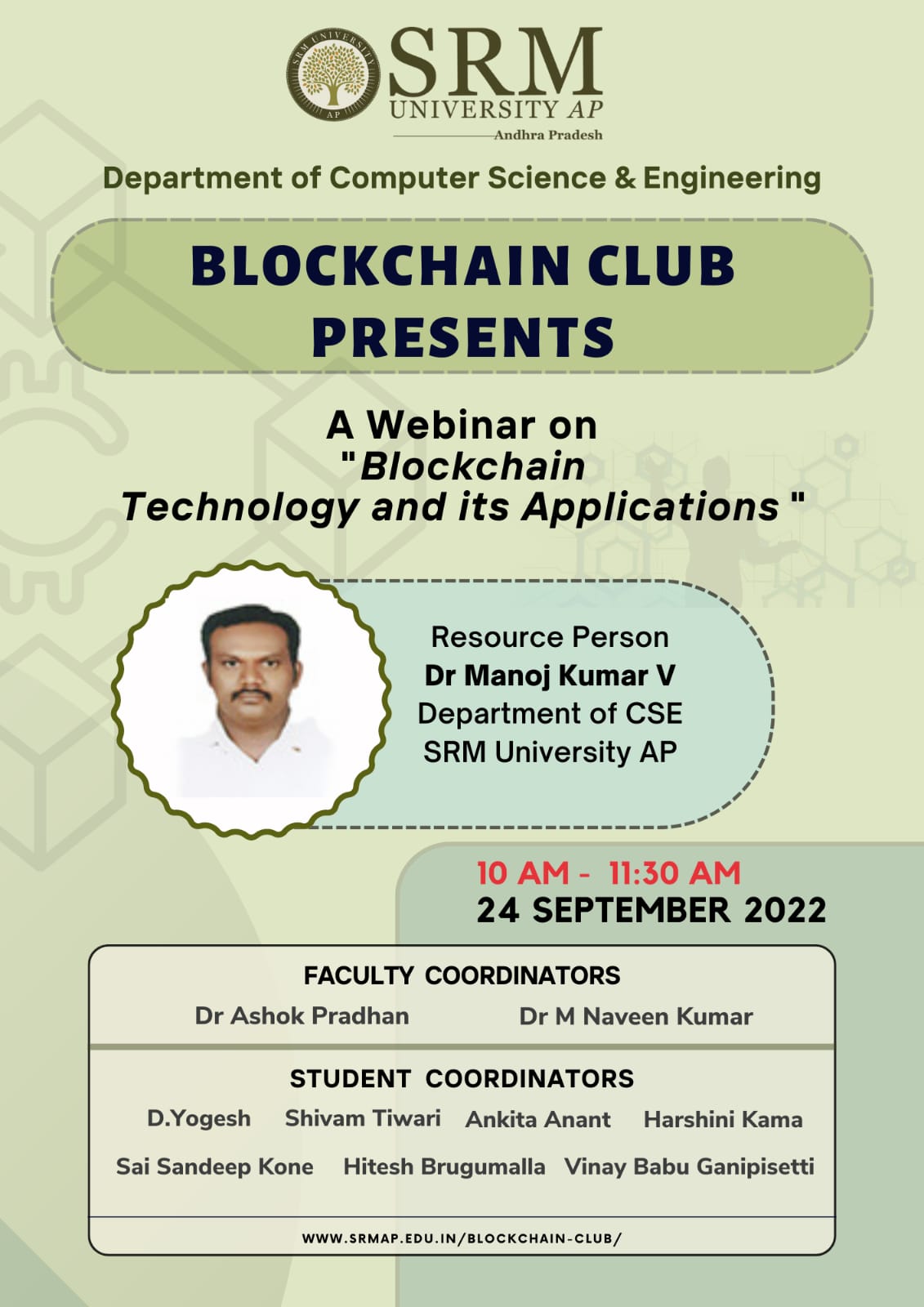 Blockchain is a digital ledger of any transactions or contracts that need to be independently recorded. This technology underpins digital currency transactions. It can be utilised in many industries, including Financial Services, Healthcare, Government, Travel and Hospitality, and many more. The Blockchain club of the Department of Computer Science and Engineering is hosting a webinar on Blockchain Technology and its applications.
Blockchain is a digital ledger of any transactions or contracts that need to be independently recorded. This technology underpins digital currency transactions. It can be utilised in many industries, including Financial Services, Healthcare, Government, Travel and Hospitality, and many more. The Blockchain club of the Department of Computer Science and Engineering is hosting a webinar on Blockchain Technology and its applications.Date: September 24, 2022
Time: 10.00 AM to 11.30 AM
Assistant Prof Dr Manoj Kumar V of the Department of Computer Science and Engineering, will handle the session. More than 130 participants will be attending the programme.
About the speaker
Dr Manoj Kumar V did his PhD from NIT Tiruchirappalli. He has teaching experience at VIT- AP university, Anjalai Ammal Mahalingam Engineering College, Tamil Nadu, and Mount Zion College of Engineering and Technology, Tamil Nadu. Internet of Things, Blockchain, and Cryptocurrency are his primary research interests.
Click here to join the webinar!
Continue reading → - Highly-stable amine-free CsPbBr3 PNCs for display applications September 22, 2022

The Department of Chemistry is glad to announce that Dr Nimai Mishra, Assistant Professor, along with his research group comprising PhD scholars, Syed Akhil, Manoj Palabathuni, Subarna Biswas, Rahul Singh, have published an article titled Highly-Stable Amine-Free CsPbBr3 Perovskite Nanocrystals for Perovskite-Based Display Applications in the journal ACS Applied Nano Materials published by the American Chemical Society, having an impact factor of 6.14.
Colloidally synthesised cesium lead halide (CsPbX3; X=Cl, Br, and I) perovskite nanocrystals (PNCs) often suffer from poor ambient and environmental stability conditions, limiting their practical applications. The commonly used surfactant oleylamine is converted to oleylammonium cation, which pulls out the halide anion from the PNCs surface, thus disrupting the nanocrystal’s structural integrity and stability.
The research group has developed a simple, completely amine-free colloidal synthesis with a hot injection method in open-atmospheric conditions and introduced bromooctane as a bromine precursor to overcome the above issues. These, as synthesized amine-free PNCs, showed a photoluminescence quantum yield (PLQY) of around 60 %, and the size of PNCs is ~25 nm. Moreover, these amine-free PNCs were highly stable in the colloidal solution and thin films for more than five months in ambient conditions, with 66% of its initial PLQY.
In addition, these PNCs have shown exceptional stability under different environmental conditions, with 44 % of initial PL even after 6 hours of water treatment and 28 % of initial PL under ethanol treatment for 120 minutes. Furthermore, it has exhibited excellent photostability for 96 hours and retained 36 % of its initial PL under ceaseless UV light irradiation at 365 nm (8 W/cm2). Additionally, these PNCs have good stability upon heat treatment and maintained 34 % of initial PL upon heating up to 90 ºC.
The research team has also successfully fabricated the green-emitting down-conversion LED using these amine-free PNCs. Thus, they visualize that these amine-free CsPbBr3 PNCs are perhaps the ideal candidates for perovskite-based display applications.
Continue reading →
- Molecular design to store solar energy September 22, 2022
 India has an ambitious target of achieving 300 GW of solar power by 2030. Conventional methods for producing solar power involve absorbing sunlight by a molecule and converting it directly into electricity. This is possible only during the daytime when sunlight is available. An interesting and complementary prospect is storing the absorbed solar energy by converting it into a different form of energy, such as chemical energy, which can then be transformed into electrical energy when sunlight is not available during the night-time.
India has an ambitious target of achieving 300 GW of solar power by 2030. Conventional methods for producing solar power involve absorbing sunlight by a molecule and converting it directly into electricity. This is possible only during the daytime when sunlight is available. An interesting and complementary prospect is storing the absorbed solar energy by converting it into a different form of energy, such as chemical energy, which can then be transformed into electrical energy when sunlight is not available during the night-time.To realise this prospect, Assistant Professor Dr Baswanth Oruganti from the Department of Chemistry has designed a molecule that can absorb solar energy and convert it into the chemical energy of the bonds. His paper titled Modulating the Photocyclization Reactivity of Diarylethenes through Changes in the Excited-State Aromaticity of the π-Linker has been published in the Journal of Organic Chemistry, on Cover Page, with an impact factor of 4.2. He is both the first author as well as the corresponding author of the article. For this project, he has collaborated with Prof Bo Durbeej, Division of Theoretical Chemistry, Department of Physics, Chemistry, and Biology (IFM), Linköping University, Sweden.
Abstract
In recent years, the concept of excited-state aromaticity and its applications in photophysics and photochemistry has attracted considerable research interest. Our study uses quantum chemical calculations to systematically investigate if the photocyclization reactivity of diarylethene switches can be controlled by the excited-state aromaticity of the ethene bridge. Indeed, we demonstrate that these switches can be transformed from being highly reactive to completely non-reactive by changing the excited-state character of the bridge from anti-aromatic to aromatic.
Generally, molecules tend to move from a high-energy state to a low-energy state, as the lowering of energy increases the stability of the molecule and makes it chemically less reactive. In contrast, the present study shows that it is possible to chemically transform a molecule from a low-energy (aromatic) state to a high-energy (non-aromatic) state by absorption of light. This reaction occurs via a high-energy (anti-aromatic) electronically excited state of the molecule induced by light and has potential applications for storing solar energy in the form of chemical energy.
One challenge in the design of molecular solar energy storage systems, such as the diarylbenzene designed in the study, is that it is difficult to store solar energy for a longer period due to the instability of the newly formed chemical bonds at room temperature. To store solar energy for a longer period, one needs to compromise on the amount of energy stored in the bonds. In this regard, in the future, researchers are planning to optimise their molecular design by finding the right balance between the amount of solar energy stored and the time period for which it can be stored.
Continue reading → - Data is the new oil: The Fundamentals of Linux and Data Analytics September 21, 2022
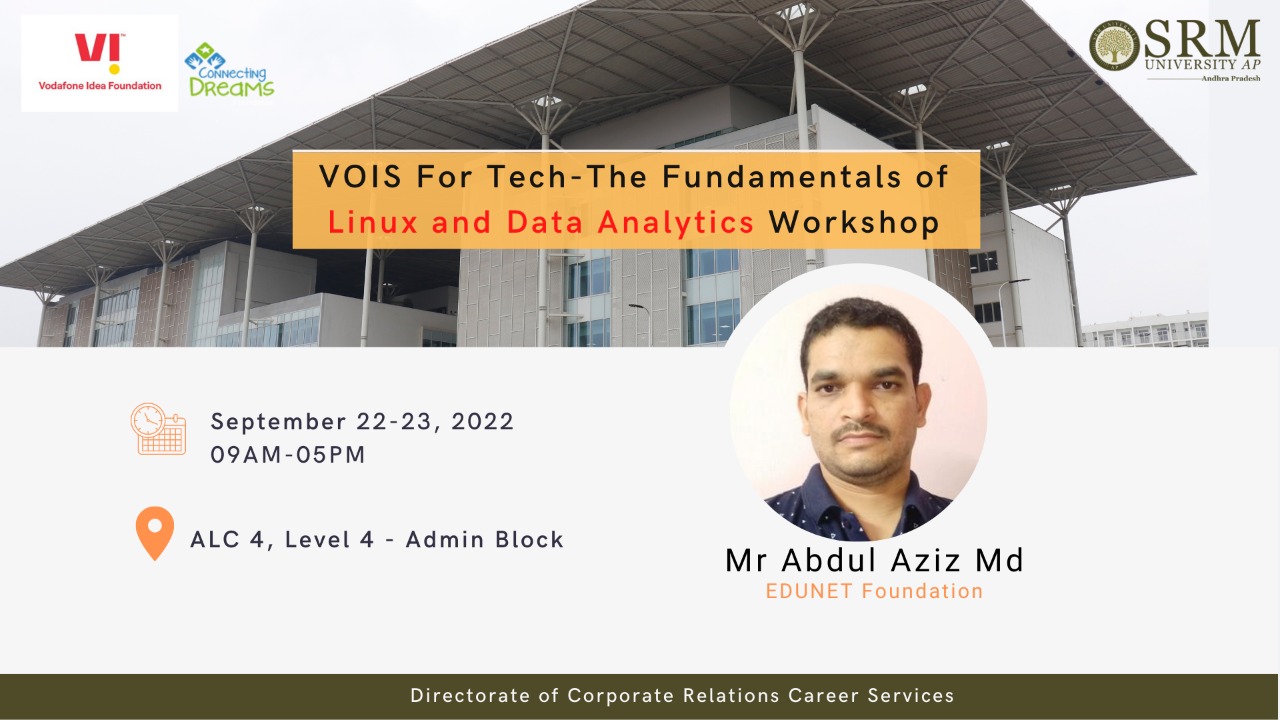 Connectivity and data are the substrata of the fourth industrial revolution. From tip to toe, the job market is data-driven and requires more IT support than ever. There is a massive demand for data analysts in the industry, and organisations hire them in bulk as they deal with data daily. The Directorate of Corporate Relations and Career Services is conducting a workshop VOIS for Tech- The Fundamentals of Linux and Data Analytics to discuss its various aspects. Mr Abdul Aziz Md from EDUNET Foundation will be guiding the workshop.
Connectivity and data are the substrata of the fourth industrial revolution. From tip to toe, the job market is data-driven and requires more IT support than ever. There is a massive demand for data analysts in the industry, and organisations hire them in bulk as they deal with data daily. The Directorate of Corporate Relations and Career Services is conducting a workshop VOIS for Tech- The Fundamentals of Linux and Data Analytics to discuss its various aspects. Mr Abdul Aziz Md from EDUNET Foundation will be guiding the workshop.Date: September 22&23, 2022
Time: 9.00 AM to 5.00 PM
Venue: ALC 4 Level 4 – Admin Block
About the speaker
Abdul Aziz Md joined EDUNET Foundation on March 2022 as a Master Trainer. He has completed an MTech in Artificial Intelligence from the University of Hyderabad, Hyderabad. He has 8+ years of experience in academics and research. His Areas of Interest are Artificial Intelligence, Machine Learning, Deep Learning, and Computer vision. He worked as an Assistant Professor at the CSE department of Rajiv Gandhi University of Knowledge Technologies (RGUKT), RK Valley campus, Andhra Pradesh, before starting his journey with the EDUNET Foundation.
Continue reading → - Navigate your tomorrow today: Education Fair 2022 September 21, 2022
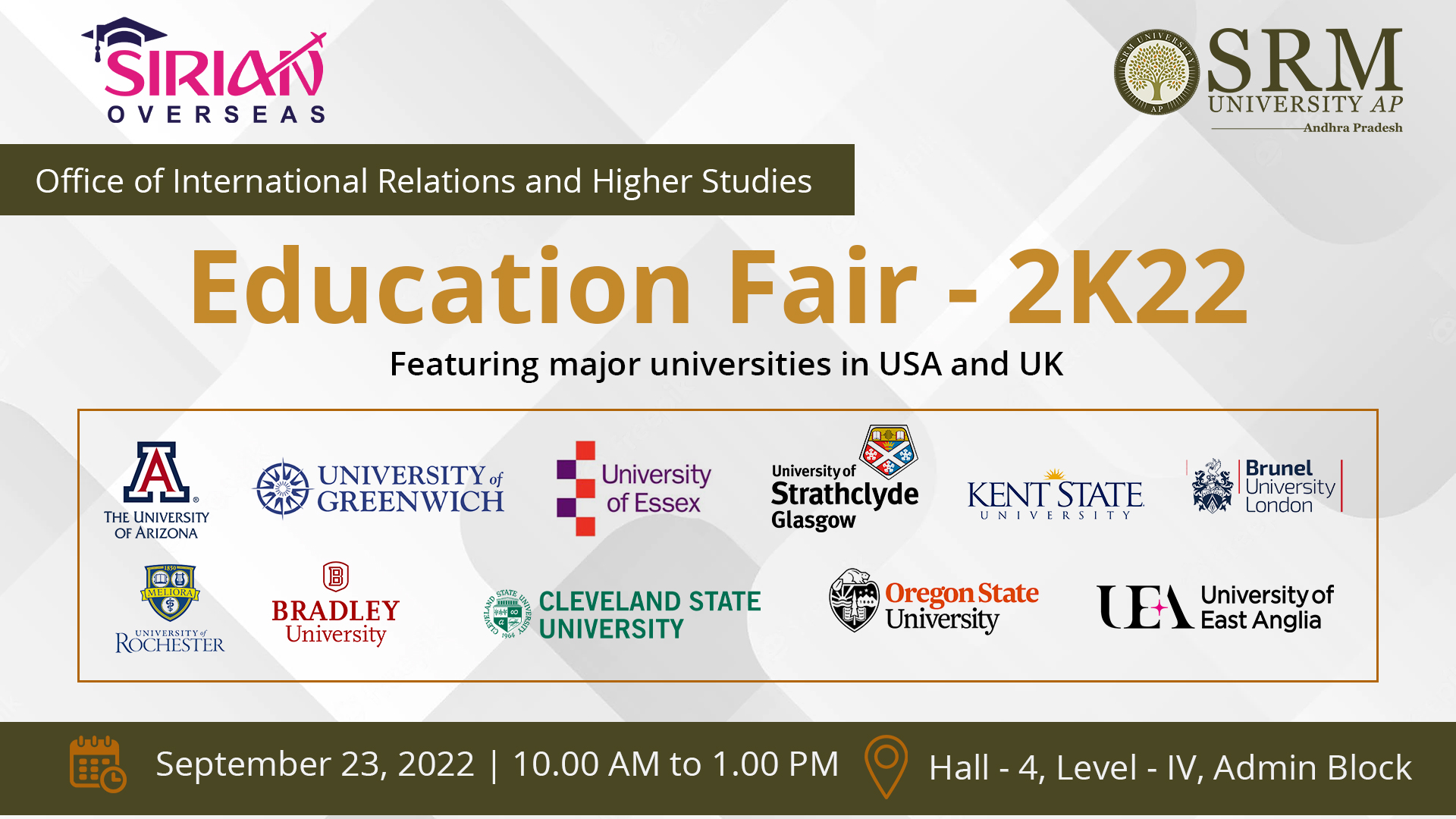 International education equips students with a broader worldview and firsthand experience of various cultures. It multiplies career opportunities and personal connections. Recognising the significance of higher education abroad isn’t enough; one must know how to get into the dream institution. The Office of International Relations and Higher Studies is yet again ready to assist students in navigating the different career options they will encounter in the higher education spectrum. Bringing the Education Fair 2022 to provide thorough guidance about the universities and programmes awaiting you across the globe.
International education equips students with a broader worldview and firsthand experience of various cultures. It multiplies career opportunities and personal connections. Recognising the significance of higher education abroad isn’t enough; one must know how to get into the dream institution. The Office of International Relations and Higher Studies is yet again ready to assist students in navigating the different career options they will encounter in the higher education spectrum. Bringing the Education Fair 2022 to provide thorough guidance about the universities and programmes awaiting you across the globe.Date: September 23, 2022
Time: 10.00 AM to 1.00 PM
Venue: Hall- 4, Level- IV, Admin Block
The Education Fair offers a golden chance to explore a diverse range of study programmes with our vast network of partner universities which can accommodate students from any educational background. Major USA and UK universities are participating in this greatly anticipated event. Highly experienced university representatives will be present on the occasion to pour light into the students’ higher education dreams.
Join the education fair and set the right direction for a better future!
Participating universities
• Bradley University – USA
• Cleveland State University – USA
• Oregon State University – USA
• Kent State University – USA
• University of Arizona – USA
• University of Rochester – USA
• University of Strathclyde Glasgow – UK
• University of Essex – UK
• Brunel University, London – UK
• University of East Anglia – UK
• University of Greenwich – UK
Continue reading → - Presented paper at the East Asian Economic Association Convention September 21, 2022
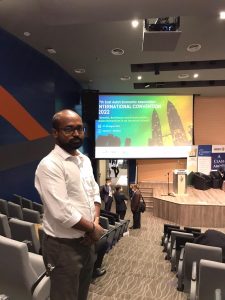
Dr J Vineesh Prakash, Assistant Professor, Department of Economics, presented a paper at the 17th East Asian Economic Association (EAEA) convention that was held on August 27-28, 2022 at Sunway University, Kuala Lumpur, Malaysia.The theme of the convention was “Growth, Resilience and Sustainability: Asian Dynamism in an Uncertain World”.
The East Asian Economic Association (EAEA) was founded in 1987 as the first international academic organisation devoted to East Asian economics. The international convention is its annual conference where papers for publication in the Asian Economic Journal are discussed.
Dr Vineesh presented the paper titled Does Business Group Affiliation Enhance Firm-Level Profitability? Evidence from Indian Automotive Component Industry, that addresses the growing competitive and volatile nature of economic sphere by testing the persistence of profit in a highly evolving emerging country environment such as India.
Emerging economies, such as India, confront different challenges than developed economies. The country has witnessed diverse regulatory environments, varying from highly regulated to more liberal ones. The more liberal environment coupled with the entry of overseas players into this realm has a definite impact on the existing industrial structure, thereby creating a volatile, ever evolving competitive environment.
The paper aims to address this issue and seeks to validate the part played by RBV in generating inimitable capabilities in a context-specific setting of a particular industry, i.e., the Indian automotive component industry. It also analyses the part played by business group affiliation in the post-reform era and its influence on profitability.
The paper found that profitability has moderate-to-high persistence and the variables, such as business group firms with overseas investments, export intensity, firm size, labour productivity growth, and past R&D intensity, have a contributory role in enhancing a firm’s profitability. Other variables such as business group affiliation, firm’s age, firm’s leverage, capital intensity, and A&M intensity have found to exercise a detrimental impact on the firm’s profitability.
Social implications of the research
The results, as reported in this paper, have some important implications for different stakeholders like managers, regulators, policymakers, etc. The finding that past R&D intensity has a positive influence on current profitability is significant to managers so they can allocate appropriate resources to fund such projects without many apprehensions.
The proof that labour productivity growth and profitability are positively related implies that managers could further focus on various in-house skill development programs to enhance labour productivity.
The finding of a positive influence of exports on profitability indicates that managers could further explore the external markets to boost up profitability as export markets are reportedly far more rewarding.
The discovery of moderate to high profit persistence has an important implication for regulators in order to facilitate healthier competition among firms. The moderate to high profitability persistence implies that the regulators have not managed to instill a reasonable level of competition in the industry through carefully crafted interventions, thereby facilitating its growth.
Continue reading → - How to write a compelling SOP and LOR? September 21, 2022
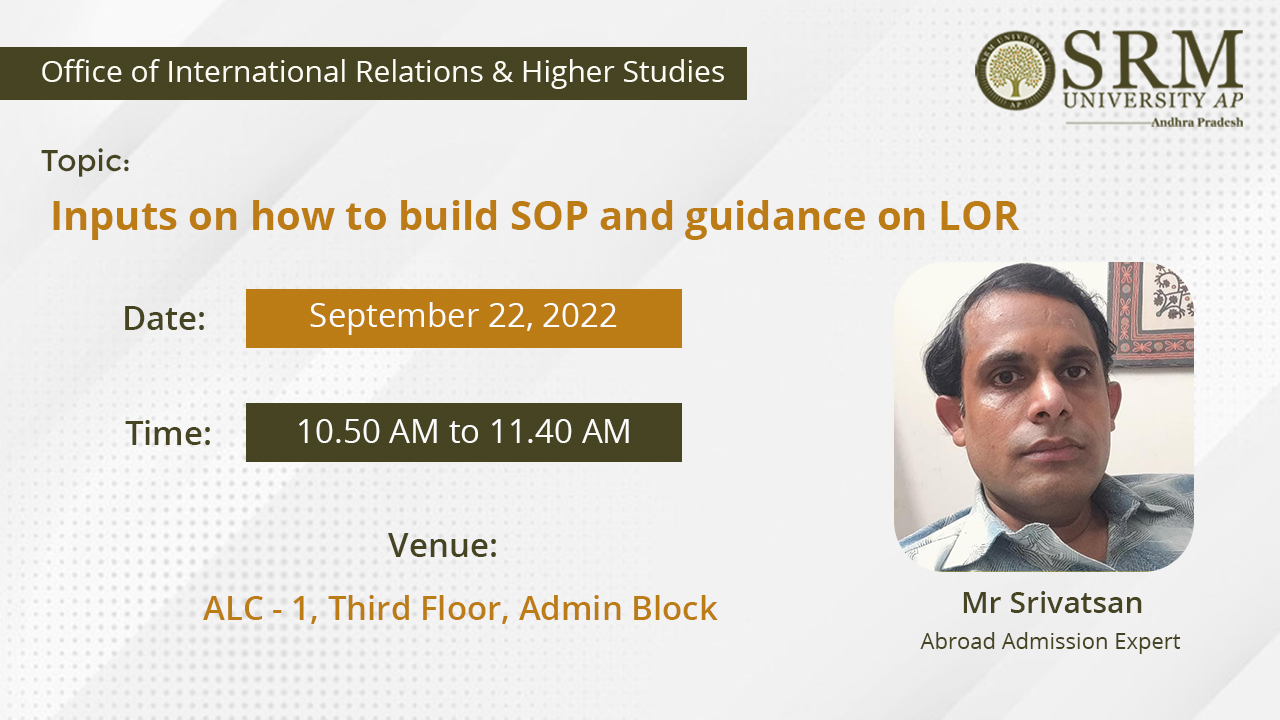
The Office of International Relations and Higher Studies is organising a webinar on “Inputs on how to build SOP and guidance on LOR” on September 22, 2022 from 10.50 am to 11.40 am. The session will be handled by Mr Srivatsan, an expert in abroad admissions.
Drafting a Statement of Purpose (SOP) and Letter of Recommendation (LOR) is an art. While an SOP is written on your own, an LOR is a letter that you receive from your teacher/professor. An SOP often follows a standardised format. There are several questions you need to answer in this document which will in turn reflect your real purpose in pursuing higher studies abroad. Most of the time, students lack clarity as to what they should emphasize in their SOPs. Proper guidance and assistance in this regard will help you address a lot of your queries.
Similarly, LOR writing also follows a pattern. There are different types of LORs such as Academic LOR, Professional LOR etc. Having a broader picture as to what aspects of your capabilities you wish to highlight will help your mentor to draft the letter accordingly.
In this session, a majority of your concerns regarding SOP and LOR writing will be addressed. The session intends to touch upon the various aspects associated with formatting these documents. Receiving the right guidance and tutoring will certainly help you draft a convincing SOP and credible LOR.
Speaker’s Profile
Mr Srivatsan is a Software Engineer by profession. He completed his Bachelor’s in Engineering with a major in Computer Science and pursued Master’s in Computer Science abroad at Wayne State University, Detroit. After a short dabble in Software Development and Testing with Microsoft, Mr Srivatsan returned to India having realised that his passion was teaching. He has been associated with Jamboree since 2014, after teaching Quantitative, Verbal, Aptitude, and Soft Skills. He has mentored a lot of students, placing some in Ivy League Schools. An avid Ultra Marathoner, he imparts the skills to his students to make sure they reach the heights they want.
- Edala Naveen climbing the success ladder September 20, 2022
 The moment he got the placement offer was surreal for Edala Naveen from the Department of Computer Science Engineering. Naveen was incredibly pleased with the opportunity. He has been placed at Crossover with an exciting offer of 44.91 LPA. He will be working at the company as an innovator to handle multiple technology stacks and develop projects and research work for use across the group of companies. He believes that his role in the company itself beckons interesting challenges and that he is in a well-poised position to make maximum use of it.
The moment he got the placement offer was surreal for Edala Naveen from the Department of Computer Science Engineering. Naveen was incredibly pleased with the opportunity. He has been placed at Crossover with an exciting offer of 44.91 LPA. He will be working at the company as an innovator to handle multiple technology stacks and develop projects and research work for use across the group of companies. He believes that his role in the company itself beckons interesting challenges and that he is in a well-poised position to make maximum use of it.The training he received from the university has largely been from the ISCP and ISES subjects. These subjects are beneficial in preparing for GRE and IELTS and thus helped him clear the assessments for the placement. He secured high scores for CSAT and GRE and aced IELTS with a score of 8.5 in 9. He could also crack the coding tests with the knowledge he earned from the ISCP classes at the university.
Naveen was in awe of the Next Tech Lab of the university, which was a robust support system for him throughout the process. “Not only did the student-run nature of the lab help me have a safe environment to fail faster, but it also helped me to maintain the sense of autonomy that ultimately provided me with the confidence to attempt and clear the role’s requirements,” he said.
He was impressed with the personnel and staff who had helped him by availing resources and knowledge when he reached out to them. The constant assistance from the Directorate of Corporate Relations and Career Services was a valuable addition to his preparation for the technical interviews. He conveyed his gratitude to his former professors; Dr Prateek from Screenwriting, Dr Anupama Ghattu from Teaching and Learning, and Dr Priyanka from Computer Organisation and Architecture. Their patience and welcoming learning environment allowed him to express and learn from his mistakes.
Naveen considers this placement an excellent stepping stone to launching a career. He aspires to continue his higher education alongside this job. In the near future, he wishes to gather the experience and technical skills necessary to give back to the community through education.
Continue reading → - Dr Kakumani K C Deepthi September 20, 2022
- Mental health of school students during the COVID-19 pandemic in India September 20, 2022
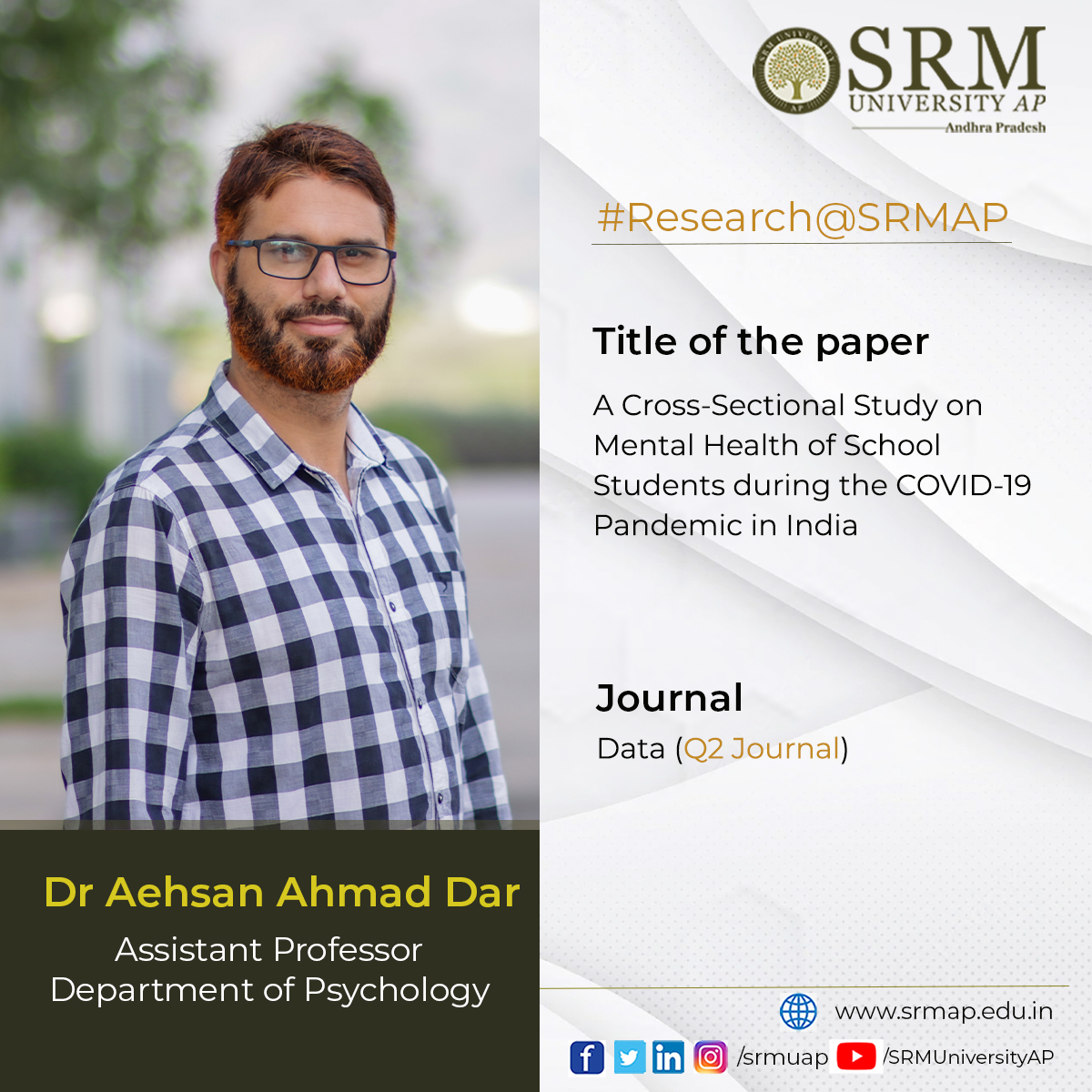
Dr Aehsan Ahmad Dar, Assistant Professor, Department of Psychology, published the article titled “A Cross-Sectional Study on Mental Health of School Students during the COVID-19 Pandemic in India” in the journal Data in collaboration with academicians from different universities across the country and abroad.
The present study estimated the mental health of school students during the COVID-19 pandemic. The findings revealed that the COVID-19 pandemic caused stress which increased the levels of anxiety and depression among the students. However, social support from family and friends was found to be a protective factor for mental health.
The findings of the research will serve as a reliable source of information for mental health professionals and policymakers to better understand the impact of the COVID-19 pandemic and other traumatic experiences on mental health. Therefore, necessary efforts are suggested to provide mental health support services to prevent the development of mental disorders.
Dr Aehsan’s future research plan is to study the mental health of youth and ascertain its risk and protective factors. About 19% of the world’s children live in India, which constitutes 42% of the total Indian population, and nearly half of these children are vulnerable and need care and protection. Due to various traumatic experiences, stress has increased among young people resulting in the development of various physical and mental disorders.
His research will focus on the pathogenic (posttraumatic stress disorder, depression, anxiety, somatization) and salutogenic (posttraumatic growth and resilience) consequences of trauma to help the youth withstand adverse experiences to develop psychological competence. The research will provide insights into the mental health status of youth that would be helpful for the administration, policymakers, and other voluntary organizations to understand effective ways to devise and implement the best intervention programs for maximizing mental health protective factors and minimizing its risk factors.
Continue reading →

